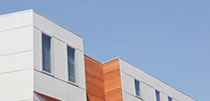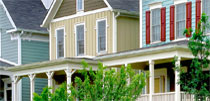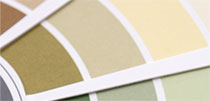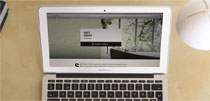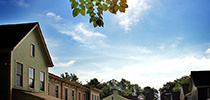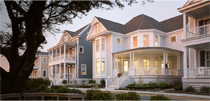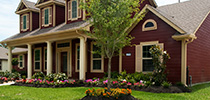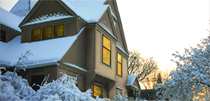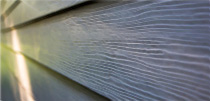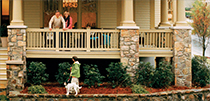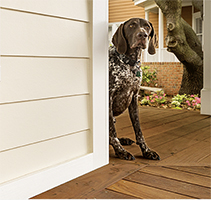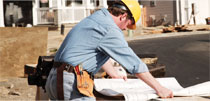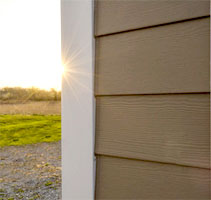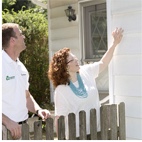Nous répondons aux questions qu’on nous pose fréquemment au sujet de nos produits.
Le choix du bardage pour sa maison peut s’avérer un processus difficile. On doit se familiariser avec un tout nouveau domaine, ce qui peut donner lieu à de nombreuses questions.
Voici les questions les plus fréquemment posées par les propriétaires :
Où puis-je acheter le bardage à clin HardiePlank®, le bardage vertical HardiePanel®, les planches HardieTrim® ou le bardage HardieShingle® ?
Puisque vous utiliserez les services d’un entrepreneur ou d’un constructeur pour l’installation des produits James Hardie®, ce sont ces derniers qui achèteront les matériaux nécessaires pour vous. Vous pouvez également communiquer avec le service à la clientèle en composant le 1-888-JHARDIE pour connaître le nom du représentant James Hardie le plus près de chez vous.
Combien coûte le bardage à clin HardiePlank® ?
Votre entrepreneur vous fournira une estimation pour votre projet, y compris le coût des matériaux et de la main-d’œuvre. Vous pouvez également communiquer avec le service à la clientèle en composant le 1-888-JHARDIE pour connaître le nom du représentant James Hardie le plus près de chez vous.
Comment le prix du bardage Hardie se compare-t-il au prix du parement en brique ou du bardage en vinyle ?
Bien que les prix varient d’un marché à l’autre, voici généralement comment le prix installé du bardage HardiePlank® se compare à celui des produits concurrentiels :
· plus cher que le vinyle ;
· moins cher que la brique ;
· même prix ou moins cher que le parement en aggloméré ou en
composite ;
· moins cher que le stuc synthétique.
Quels types de boiseries peut-on utiliser avec le bardage à clin HardiePlank® ?
Les types de boiseries suivants peuvent être utilisés avec le bardage à clin HardiePlank® :
· HardieTrim®
· fibrociment
· bois véritable
· bois d’ingénierie
· vinyle
· aluminium enduit ou résistant à la corrosion
Puis-je utiliser le bardage HardiePanel® comme matériau de bande de finition sur une maison mobile ?
Oui. Cependant, on doit l’installer conformément à nos instructions d’installation écrites pour le bardage HardiePanel® en ce qui a trait à l’ossature, aux joints, à la peinture et à l’espace de dégagement au-dessus du sol. James Hardie offre une garantie limitée d’un an sur le bardage HardiePanel® utilisé comme bande de finition sur une maison mobile.
Où puis-acheter les panneaux HardieBacker® ?
Utilisez l’outil localisateur de marchand James Hardie en ligne ou communiquez avec le service à la clientèle en composant le 1-888-JHARDIE pour connaître le nom du représentant James Hardie le plus près de chez vous. Les panneaux en ciment HardieBacker® sont aussi généralement vendus au détail dans les magasins Home Depot et Lowe’s.
Comment dois-je couper les panneaux HardieBacker® ?
Les panneaux HardieBacker® peuvent être coupés au moyen d’un couteau universel ou d’un tranche-fils au carbure, ou encore avec des cisailles (manuelles, électriques ou pneumatiques). Pour en savoir plus, visitez www.HardieBacker.com.
À quelles fins utilise-t-on le pare-air HardieWrap® ?
Le pare-air HardieWrap® peut être utilisé comme barrière étanche à l'eau ET comme pare-air conformément aux exigences des codes du bâtiment résidentiels et commerciaux à l’échelle nationale. Le pare-air HardieWrap® doit être installé sur le revêtement sous le bardage extérieur dans le but de réduire les infiltrations d’eau et d’air, tout en permettant à l’eau de s’échapper de l’intérieur des murs avant que celle-ci ne puisse causer des dommages.
Qu’est-ce qui fait que le pare-air HardieWrap® est supérieur aux autres types de pare-air ?
Selon des essais indépendants, la performance du pare-air HardieWrap® a surpassé celle des principaux produits concurrentiels pour chacun des critères suivants : étanchéité à l’eau, résistance à la pénétration de l’air et résistance au déchirement.
Combien coûte le pare-air HardieWrap® ?
Le pare-air HardieWrap® est vendu à un prix concurrentiel. Pour obtenir des renseignements précis, communiquez avec un représentant James Hardie en composant le 1-866-4HARDIE (1-866-442-7343).
Où puis-je trouver des instructions d’installation et des guides de meilleures pratiques pour les produits de James Hardie ?
Visitez HardieInstallation.com pour obtenir des instructions d’installation, des vidéos et des guides de meilleures pratiques pour les produits James Hardie.
HardieBacker FAQs
What thickness is used in floor applications?
Both may be used, but we recommend HardieBacker 1/4" cement board for floor applications, unless 1/2" thickness is needed for transition.
Can HardieBacker 1/4'' board be used in a shower wall application? Is a vapor barrier required?
Yes, HardieBacker 1/4'' cement board may be used in a shower. However, we recommend HardieBacker 500 if you need to make a smooth transition to drywall. The board must be mechanically fastened every 8'' on center to the wood or metal studs spaced a maximum of 16'' on center. A vapor barrier is needed if required by local building codes.
Where do I purchase HardieBacker® cement board?
Home Depot® and Lowe's® Home Improvement both stock HardieBacker® cement board or call customer service at 1-888-JHARDIE for your closest sales representative.
How do I cut HardieBacker® cement board?
HardieBacker board may be cut with a carbide-tipped scoring knife (found at Home Depot® and Lowe's® Home Improvement stores), utility knife, or cutting shears (manual, electric or pneumatic). If you use a grinder be sure to cut outside and use a dust reducing circular saw with a Diablo® HardieBlade™ circular saw for more protection use a HEPA vacuum extraction.
Which side goes up, smooth or rough?
Either is acceptable, but we recommend that the smooth side with the nailing pattern of every 8" on center go up.
What subfloor should HardieBacker® cement board be installed over?
The minimum subfloor specified is 5/8" exterior grade plywood or 23/32'' exterior grade OSB subflooring. HardieBacker board must be installed in accordance with local building codes and the floor must be engineered not to exceed the L/360 deflection criteria, including live and dead design loads, for the specific joist spacing used. HardieBacker board is not designed for use over concrete.
Why do I have to use thinset between HardieBacker® cement board and the subfloor?
Unmodified thinset (ANSI 118.1) or acrylic modified thinset (ANSI 118.4) is specified between the HardieBacker board and the subfloor to eliminate any deviations between our product and the subfloor. This decreases the probability of popping or cracking tiles due to deflection and air pockets.
What do you mean by ''modified thinset''?
The modified thinset used with our product is a fortified cement-based mortar and should specifically conform to ANSI (American National Standards Institute) A 118.4. The thinset can be fortified in a pre-mixed powder form or with a liquid additive.
Can I use liquid nails or glue with HardieBacker® cement board?
No. Where HardieBacker board is being installed over a code-complying subfloor for the attachment of tile, the board is installed over a 3/32''-1/4'' thick bed of bonding mortar and then nailed down. ''Liquid Nails'' is not a bonding mortar. It is a structural adhesive generally used to bond the subfloor to the floor joists just prior to nailing. It creates a very solid joint between the surface of the floor joist and the subfloor and aids in reducing floor squeak. The properties of Liquid Nails are such that it is applied via a tube in the form of a bead-like caulking. It is not trowelable like a mortar and therefore results in high ridges with unsupported areas that can deflect under load, resulting in cracked tile.
Where HardieBacker board is being installed directly to wood or metal framing, the use of a structural adhesive in addition to mechanical fastening can be used. However, the board must be forced into the structural adhesive almost immediately upon application to insure that no ridge or crown is formed. The creation of a crown or ridge will result in an additional thickness of mortar being applied to fill in the valley created by the crown. This will require a longer curing time and result in a weaker bond between the tile and the mortar and the underlayment. The use of a structural adhesive does not result in fewer fasteners being required.
What is the correct fastener pattern for installing HardieBacker® cement board?
Fasten HardieBacker sheets with proper nails or screws (as listed in ''Materials Required'' in the backer installation instructions) every 8'' around the perimeter and all supporting studs. Keep fasteners between 3/8'' and 3/4'' from sheet edges and 2'' in from sheet corners.
What type of fastener do you recommend for floor and wall applications of HardieBacker® cement board?
In compliance with the tile industry, James Hardie recommends 1-1/4'' long galvanized or stainless steel roofing nails (0.121'' shank x 3/8'' HD) or 1-1/4'' long corrosion resistant ribbed waferhead screws (No. 8-18 x 3/8'' HD).
Why can't I get screws to sit flush with the HardieBacker® cement board?
The screws that you are using do not have the power to rout out the material in order for the screw head to sit flush. Be sure to use the specified screws (1-1/4'' No.8-18 by 3/8'' HD Hi-Lo S or S-12 for metal studs, ribbed phil wafer head, self drilling, corrosion-resistant screws). If you continue to have difficulties, we recommend switching to 1-1/4'' galvanized roofing nails.
Where can I get the 2'' wide high-strength alkali-resistant glass fiber tape?
Home Depot stores and Lowe's Home Improvement Warehouses.
Can I put HardieBacker(r) cement board over linoleum or vinyl composite tile?
Yes, Hardiebacker can go over linoleum or vinyl composite tile. Even though you may go over vinyl composite tile, James Hardie does not recommend you install HardieBacker board over cushioned vinyl. Follow HardieBacker floor installation instructions for complete details.
Can I use HardieBacker(r) cement board as a fireplace facing?
Yes, HardieBacker board can be used as a fireplace facing. HardieBacker 1/4'' board can be used as a component in a 1-hour fire resistive construction when installed in compliance with National Evaluation Report NER-405. HardieBacker boards are recognized as non-combustible, when tested according to ASTM E 136.
Can I use HardieBacker cement board in an exterior application?
HardieBacker cement board may be used in some exterior applications, download the installation guide for more details.

